Bing Crosby sang “Chestnuts roasting on an open fire,” and when most of us think of eating chestnuts that’s exactly the image that comes to mind – a traditional Christmas scene with the decorated tree in the corner, robins hopping in the snow outside, and a line of chestnuts slowly grilling above the embers of burning logs.
In fact we associate roasted chestnuts with our Anglo-German Christmas traditions, but they’re eaten this way in most of the northern hemisphere. Go to Istanbul and you’ll see chestnut carts on the street; they’ve been eaten in France since at least the 16th century, and in Spain for even longer.
Chestnuts are nutritious – low in protein and fat, unlike other nuts, but a good source of carbs, especially starch; they contain about twice as much starch as potatoes. They’re also the only nut that contains Vitamin C.
Chestnuts – The All-Purpose Food
As well as simply roasting chestnuts there are many other ways to prepare them. They can be boiled, steamed, grilled or toasted. Sliced and steamed, they make a good side vegetable – especially if you can splash them in butter and salt. They can even be eaten raw, although unless they’re fully ripe they have a slightly bitter taste.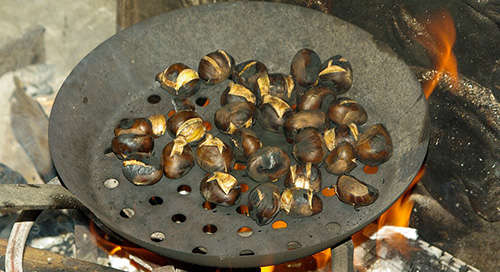 In Hungary cooked chestnuts are pureed, mixed with sugar and rum, forced through a ricer, then topped with whipped cream to make a tasty dessert. The Swiss do something similar, mixing pureed chestnuts with kirsch and butter. In France and Germany they’re chopped and used to stuff poultry. The French also can the cooked chestnuts in sugar syrup.
In Hungary cooked chestnuts are pureed, mixed with sugar and rum, forced through a ricer, then topped with whipped cream to make a tasty dessert. The Swiss do something similar, mixing pureed chestnuts with kirsch and butter. In France and Germany they’re chopped and used to stuff poultry. The French also can the cooked chestnuts in sugar syrup.
Chestnut juice can be fermented into a beer, or the fermented juice can be boiled down to produce sugar. Juice from ripe nuts needs less fermentation; immature chestnuts are starchy, but as they ripen the starch is converted to natural sugars. Once the juice has been extracted the crushed nuts can be roasted and used as a coffee substitute. It’s a very useful and versatile nut.
From a prepper point of view, though, there’s something even better about chestnuts; they can be dried and ground into flour. It isn’t a cheap filler, either – something that can be used to bulk out real flour, but won’t work on its own. It’s not only possible to make bread and other baked goods from chestnut flour, but in some parts of the world it’s common. In Corsica, for example, chestnut flour is baked into bread and cakes, it’s used as a cornmeal substitute to make polenta, and it’s fried into donuts.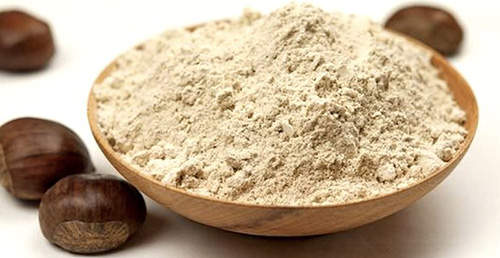 Having an alternative source of flour is very useful. You probably have a lot in your food reserves, but it won’t last forever, and what are you going to do when it’s gone? Growing grain to make flour isn’t a simple process, and it will take up a lot of your time. There are wild grasses that can be turned into flour, but the yield is a small fraction of what you’ll get from domesticated wheat or rye. Chestnuts – large, easy to harvest and found in the wild – are potentially a very valuable source of flour that will keep you supplied with bread indefinitely. The flour also stores well, and so does bread baked with it; a loaf of chestnut bread will easily last two weeks without getting stale. Chestnut flour is also gluten-free.
Having an alternative source of flour is very useful. You probably have a lot in your food reserves, but it won’t last forever, and what are you going to do when it’s gone? Growing grain to make flour isn’t a simple process, and it will take up a lot of your time. There are wild grasses that can be turned into flour, but the yield is a small fraction of what you’ll get from domesticated wheat or rye. Chestnuts – large, easy to harvest and found in the wild – are potentially a very valuable source of flour that will keep you supplied with bread indefinitely. The flour also stores well, and so does bread baked with it; a loaf of chestnut bread will easily last two weeks without getting stale. Chestnut flour is also gluten-free.
Related: The Ultimate Survival Tree That Grows on Almost Every Street in America
The Blight Disaster
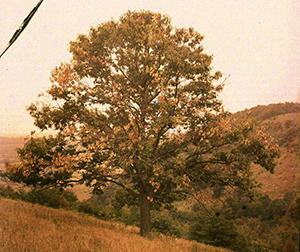
A hundred and twenty years ago the USA was awash in chestnuts. The American chestnut, Castanea dentata, was one of the most common trees in the country; in areas like the Appalachians the species accounted for a quarter of all hardwoods. Almost every house and barn east of the Mississippi was built with the American chestnut’s tough wood. Biologists estimate there were over three billion of the trees spread across the eastern states.
Then, in 1904, the chief forester at the Bronx Zoo discovered signs of chestnut blight on some of the zoo’s trees. Soon more outbreaks were found along the East Coast, and they were quickly traced to imported Japanese and Chinese chestnut trees, which were a popular import among gardeners. Chestnut blight is a fungal infection; the fungus eats the inner bark of affected trees, and works its way round the trunk in a ring. When the ring is complete, everything above it dies. By 1940 almost every American chestnut tree was dead.
However, as early as the 1930s people started working to rebuild populations of the tree. It isn’t easy, because the blight fungus can spread on the winds, but chestnut numbers are slowly rising again. Some original stands of chestnut survived, too, mostly in Michigan, Wisconsin and the Pacific Northwest. More recently scientists have created hybrid trees by breeding American chestnut with Asian varieties. Chinese and Japanese chestnut have evolved to cope with blight, so the disease rarely kills these trees, and properly bred hybrids inherit that resistance. There are also Asian and European chestnuts around, either in gardens or growing wild.
So while chestnut trees are nowhere near as numerous as they were at the start of last century, there are still enough of them around that they can be a valuable food resource in a crisis. There’s only one catch – you have just three months to harvest this year’s nuts.
Chestnuts produce distinctive fruit; each of the spiny green balls contains multiple nuts – usually three of them. These cases ripen from late summer through late fall, and when the first frosts hit they split open and fall from the trees. Gathering them at this time is ideal if you want to roast the nuts or ferment their juice; fully ripe chestnuts will yield slightly if you press them between finger and thumb, and you’ll feel a slight gap between the tough brown skin and the flesh inside. If you harvest them from the trees in early fall the nuts will be firmer, with no gap, and almost impossible to squeeze; this is the time to collect them if you want to make the best quality flour.
Related: How to Make Acorn Flour
Where Can You Find Chestnuts?
So, where can you find chestnut trees? The first thing to do is to learn to recognize them. The American chestnut is a large tree, 50 to 100 feet tall, and usually has a straight trunk. It also has distinctive leaves, which are the classic leaf shape, quite narrow and with serrated edges. From late spring it produces numerous flowers in the shape of pale green catkins up to eight inches long; later the nut cases start to grow at the base of the catkins.

The native range of the American chestnut runs from Maine to northern Florida, but humans have transplanted the tree all across the US in any area where hardwoods grow. If that hadn’t happened the species would probably be extinct – the blight fungus spores can travel six or seven miles on the wind, so isolated groups of trees outside their natural range have a better chance of survival.
One area with some large American chestnuts is Michigan, where hundreds of mature trees can be found in several places. There are more in Sherwood, Oregon, where the climate protects them against the fungus. Other pockets of healthy trees are scattered across the West.
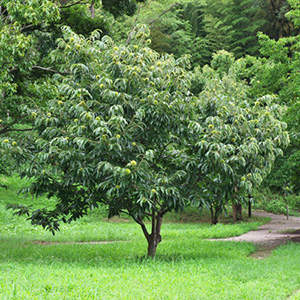
The Chinese chestnut is a smaller tree, rarely growing past 70 feet; apart from that it’s similar to the American chestnut, but can be recognized by the hairy tips of its twigs – American trees have hairless tips.
Since the blight many Chinese chestnuts have been planted for commercial production of nuts (but not of timber – its wood is far inferior to American chestnut), and there are many orchards full of them scattered across the USA. In a crisis these orchards will be a great source of food if you know where to find them.
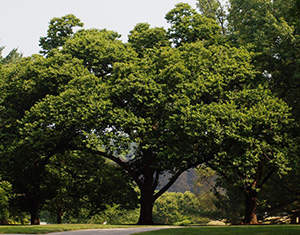 The Japanese chestnut is even smaller, usually less than 50 feet tall when mature, but like the Chinese chestnut it’s also resistant to blight.
The Japanese chestnut is even smaller, usually less than 50 feet tall when mature, but like the Chinese chestnut it’s also resistant to blight.
Because of its smaller size this tree isn’t as popular with chestnut growers, but you might find them in parks or gardens anywhere in the USA.
Related: Trees That Can Be Tapped For Sap And Syrup
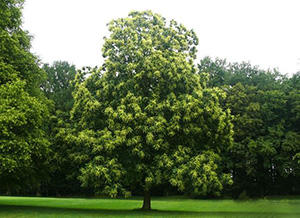
Finally the European sweet chestnut has also been introduced to the USA both as an ornamental tree and for commercial production. Chestnut blight can kill this tree, but it’s more resistant than the American chestnut.
It’s also even larger, and has the same high quality of timber. Many orchards contain European chestnuts or hybrids of the European and Chinese trees.
The introduction of chestnut blight by careless gardeners was an ecological tragedy. For preppers it’s even worse, because it made a common and valuable food source much rarer. There are still millions of chestnut trees in the USA though, and while many of these are Asian trees with poor quality timber they will still give you a good crop of nuts. It’s well worth finding out if there are any orchards or stands of wild trees in your area, because when the SHTF they’ll make a very useful addition to your diet.
You may also like:
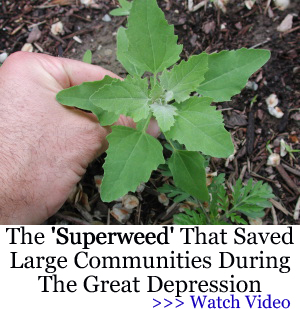 24 Lost Gardening Tips from 100 Years Ago
24 Lost Gardening Tips from 100 Years Ago
What Happens If You Smoke Mullein (Video)
The First States That Will Go Down In A Collapse. Do You Live In The Red Zone?

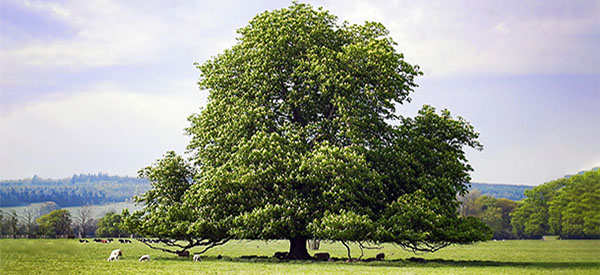













While I enjoy these articles I keep hoping that you will devote some space to information about the desert southwest; namely southern Nevada, New Mexico and Arizona. Our landscape is devoid of many plants and trees that you write often about.
And SoCal which is not completely a desert but without the major water projects that take water from other areas and bring it here would be close to a desert. There is always prickly pear and the few oaks trees that haven’t been ripped out by developers. The town of Thousand Oaks may now be down to about 27 oaks.
I live in South Dakota…most of the trees they talk about don’t grow here, because of our freezing winters! It can get to 15 – 20 below Zero!!
Yo, for me, as well. A lot of native trees were wiped out during the colonial period, but people tell me acorn hunters are killing off the blue. I have honey mesquite all over and a neighbor gave me nopale pads from a commercial variety–no thorns and the pads are thick. We need the pinyon pines back and so on. I can pick a lot of stuff, even wivian tobacco, down in the arroyos this time of year. We made jam with a barrel cactus someone cut up (cook, drain the water, cook again, then puree with fruit and sugar). Got pygmy dates growing but would like Cali Fan as they love salt and caliche. Put in garden trenches, filling them with waste wood and such, then dirt, and they’ll hold a lot of water next year in the carbon material.
The Japanese also use the chestnut as a food item. They serve it in steamed rice. They serve it as a nut in some of their confections. In the winter time street vendors sell roasted chestnuts from carts. Coming back from the bathhouse, it was delightful to duck under the curtains around the chestnut cart into the warmth of chestnuts roasting on the charcoal and get a newspaper cup full of chestnuts to take back and have with tea.
There is a Japanese sweet called yokan and kuri yokan or chestnut yokan, is my favorite yokan.
We used to buy chestnuts mail order from an orchard up in NorCal many years ago. They stopped selling and the chestnuts one buys in the grocery store starting in November are not fresh although they are sold as fresh. When we got the chestnuts from NorCal we would use them in turkey stuffing at Thanksgiving and Christmas as well as roasting in the oven.
If you are underwhelmed by the chestnuts you buy in the local supermarket, I can understand. They have to be fresh to be tasty. By the time they are harvested and go through the various warehouses until they reach the consumer here in SoCal they are a long way from being fresh. They probably still have food value but are far from being the delicious item they are when fresh.
This article has stirred my interest in searching out farmers markets to see if I can find fresh chestnuts next month.
We have some chestnut trees but I’ve never harvested any of them before. So I’m not exactly sure what the best timing is or the best ones. Since we live in different areas I’m sure you have something that grows there that doesn’t here in Kansas so maybe we can do some swapping if I can figure out the best ones to pick up or the ones to keep. I have a real great friend who lives in the same area so maybe he can give me a hand in learning. Makes for a great conversation and activity for today. If your interested let me know.
My Grandfather introduced me to chestnuts and he had several trees on his property. We would shuck them from their thorny outer skin then peel them and saute them in butter till golden. The last thing he gave me before he passed was a bag of chestnuts. I good memory that I will always keep.
have not read all the comments yet, but one thing you neglected to mention: the horse chestnut which is commonly found as an ornamental tree cannot be eaten – it is poisonous unlike the American chestnut
I was going to mention this cautionary also, if I read through the comments and found that nobody brought it up. Yes, the large, shiny horse chestnut is poisonous, so let;s all stick with its smaller relatives that are edible.
For all you college football fans, in Ohio the horse chestnut is called a “Buckeye” or buckeye nut, and that is what the Ohio State Buckeyes mascot’s head is–a horse chestnut with a sort-of-cutesy face. (Go Bucks!)
I used to hear the same thing when I was a kid. There was a huge horse chestnut tree that dropped thousands of nuts every fall. We used to throw them at each other. We always told each other not to eat them as they were poisonous.
When I saw your post, Prairie Rider, I had to find out more about horse chestnuts. Here is one site I found:
“COMMON NAME
Standardized: horse chestnut
BOTANICAL NAME
Aesculus hippocastanum L.
Plant Family: Hippocastanaceae
OVERVIEW
The horse chestnut tree grows 80 feet (25 meters) tall with leaves in clusters of 5 to 7 and white flower spikes growing at the ends of its branches. The name of the tree has many stories associated with it, but no real consensus has been reached. When the tree was brought to Britain in 1616 from the Balkans, it was called horse chestnut because the Turks would feed the seeds to their ailing horses. The tree is chiefly grown nowadays for ornamental purposes, in towns and private gardens and in parks, and along streets. The horse chestnut plant is not related to the edible chestnut, which is actually part of the oak family. Horse chestnut is relatively new to the U.S. herbal products market. Currently, it is the third best selling herbal product in Germany behind Ginkgo and St Johns Wort.
PARTS USED
Whole nuts (used to make herbal extracts and infusions for balms and creams)
TYPICAL PREPARATIONS
Traditionally the leaves and bark are used as a tea, and can also be used to make tinctures, creams, and infusions. The whole nut is preferable over the leaf and bark when it is to be used for external applications. Sometimes the leaf and bark are combined with other herbs to make cough syrups. The whole nuts are poisonous and are only to be used for external application, unless by a qualified practitioner.
PRECAUTIONS
Specific: Contains tree nut.
General: We recommend that you consult with a qualified healthcare practitioner before using herbal products, particularly if you are pregnant, nursing, or on any medications.
For educational purposes only. This information has not been evaluated by the Food and Drug Administration.
This information is not intended to diagnose, treat, cure, or prevent any disease.”
You can buy horse chestnut on line. It is pretty expensive. So, Prairie, you are right, eating the nut is not a good idea, but apparently you can make a tincture or a poultice out of it. You can also, apparently, feed it to a sick horse although how much remains a question.
So, urban legend confirmed from at least one source. Don’t eat the horse chestnuts.
As I recall, they were quite a bit bigger than regular eating chestnuts although from my 70 year old recollection of them they strongly resembled regular chestnuts.
Perhaps someone who has more current knowledge than from 70 years ago can comment on comparing horse chestnuts to edible chestnuts.
I think I’d hold off on feeding horse chestnuts to a horse; they can kill cattle. Apparently if you crush a load of them to a pulp and throw it in a pond it will stun any fish in there.
As for telling them apart, edible chestnuts come to a point at one end; horse chestnuts don’t. Chestnut husks are covered in long, sharp spines, but horse chestnut husks have fewer, and they’re short and almost warty looking. Horse chestnuts also usually (not always) only have one nut in each husk. Edible chestnuts usually have three or more nuts in each husk.
Well, that’s useful to know, Claude, that chestnuts will make catching fish easier. In the back of my mind is the idea that the outer husk of black walnuts will do the same but that is based on nothing more than a foggy recollection floating around in the vast amount of trivia I have managed to store away on my brain’s hard drive.
I don’t know about fishing regulations in other states, BUT… in Texas, it has been a serious violation, since I was a teen in 1955, to ‘fish’ with Walnut or Chestnut pulp!
Well, Johnny, in an EOTW situation getting busted by George the Game Warden is probably going to be one of our lesser worries. I am quite certain that no state allows poisoning of waters to recover fish. Certainly it is not sporting but I fear when your kids are starving, sportsman ship and fair chase will be forgotten concepts.
Using nooses and leg hold traps are also illegal in any state where I am aware of their game laws but in an EOTW situation, where my family is starving, I will catch game any way I can. Shooting over bait is verboten here in the PDRK but there is no better way to attract game and it is legal in some states.You can’t use motorized decoys either in the PDRK. You need a fishing license to catch frogs and your kids taking sand crabs at the beach are in technical violation of fish and game laws.
If it’s a serious violation to use chestnut or walnut pulp for fishing, that’s probably a pretty good hint that it’s effective! As Chuck says, if the fan is looking splattered we’re probably not going to be worrying too much about violations of fish and game law. In fact George the game warden is probably going to be out there throwing chestnut pulp in the pond right alongside us, because he has kids to feed too.
You are correct in the use of black walnut husks as a fishing aid. As kids we use to can up a portion of a creek known to have mud cats (bull head catfish) and throw in about a gallon of crushed black walnut hulls. Shortly, the fish would float tithe too and we would clean and skin them them then cook over an open fire. Good times! Sad that so much knowledge has been lost over the years and more will be unless we pass it on.
Down here in the South we call the bois d’ arc (bow dock) or Osage Orange horse chestnut or horse apple. The wood is excellent for making bows. The fruit on this tree is green and can be softball size. Funny how different areas of The country call different things by the same name. I would think I’m a survival situation that would be an important issue.
and roaches HATE the Osage oranges.
To me, like someone above, it is a Buckeye. Around these parts we carry one in our pocket for good luck.
The chocolate peanut butter Buckeye candies are quite tasty however.
I second the ‘more info about the desert southwest’ motion. I love reading these articles but the first thing I do is hit my gardening guide to see if any of the listed plants can grow/survive in my area. Most times, it’s ‘nope.’
Prickley Pear Cactus is a good one.
And tasty! Make a good first line of defense for the house, as well. There’s a little old lady down on the border who had mojados over the wall every night. She didn’t dare leave the house because of robbers. She planted nopale and Christmas cactus (not the house plant but a cholla, to explain our beloved plant to those who live in swamps) along the fence and had a cousin put up signs on the Mexican side warning people. A few years later, someone jumped the fence and made a mess in her garden. She said the screams woke up dogs for a mile around. And, she was waiting for the mojado’s lawyer to threaten to sue her for hurting his client 🙂
I like mesquite. The beans are good, but mind the thorns. They stay bush if trimmed lightly and are a legume. Mazanita are good, they grow tight and hard, twisted, my stepfather claims a couple of trainees tried to crush them with a tank, only to ride over the top (my bow is now too much for me to bend, and they were used for wagon springs). Nice berries, no thorns, but can cause fires. Very nice looking brush and a legume. If you can, one of the best thorny hedges is olive brush. Seedlings always come up covered in thorns. If you get good olives, that’s even better. Just wear cast iron gloves while picking. I have banana yucca, AKA Spanish lance/dagger, as well. Good eating from them and they get over 6 ft high with spikes on the end. Hard to cut thru (but nothing beats mazanita for that). Barrel cactus is OK, but horse crippler (shin digger) is better. Any cholla is great, and buds sell for 24 bucks a pound in season. Mustang grapes for a blind and fruit. Chayote in the summer. It grows like crazy in the heat and is good to eat. It’s better than barbed wire. Most citrus is thorny, as well. I’ve seen ocotillo weaved into a fence even corriente bulls back off from. No fruit, but wen in bloom, if you mess too much with it, Arizona’s hummingbirds have been kn own to attack, and they always go for the eyes. Bees are excellent, but the best honey bees are from the Minsterio de Agricola, which is breeding for a kinder, gentler killer bee, and doing it. Rattlers love milk, and I have never heard of them biting the one who feeds them. As an old-timer told me years ago, if it ain’t got horns, thorns, or fangs, it’s poison. That’s Arizona. We’re better set than most folks for defense. We had to be for centuries. Niio!
The south west. Maybe someone could point out to us the plants that are edile in the desert. And, what to do with them{preparation}
In a survival situation in the desert food has absolutely no importance, your every action has to be toward acquiring water and shelter. Without water and shelter you are at serious risk of death after only a few hours, not even half a day. When we camp off grid in the desert we bring our own food water and shelter. We sleep with a bottle of water because you lose enough water through breathing to start losing the hydration battle. Drinking half a liter in the middle of the night does you a world of good. And forget about getting water from a cactus, you can’t get enough to save your life.
Food is abundant in the desert, though, especially in the arroyos where there is always a trace of moisture, but it tends to be highly seasonal or difficult to gather and process. If the yuccas are flowering life is good, the blooms are a nutritious treat. Strawberry pitaya is a cactus with a delicious fruit you can eat right off the plant. Prickly pear, not so much, the fruits are good raw after you skin the spines off them, young pads are good sliced thin, fried lightly and served on good whole grain toast with cream cheese. The crowns of various large Magueys can be roasted, but they tend to have a vile flavor and it is the worst kind of work to dig one up and cut the leaves off, then dig a pit, then dig up a bunch of mesquite roots for fuel. Various greens, a few roots, have to know what the desert you’re lost in has to offer. Love me some sweet little Mexican persimmons but more than a handful will give one a series of scandalously loose bowel movements…like anywhere else, if you need food, your best bet is laying up a hundred yards from a water hole with a .308 sighting in a big ol’ mule deer, very good with roasted chestnuts!
Chestnuts are almost nonexixstant here in the Southeast.give a take on natural flour sources such as acorns.
That’s a good point, Rua! In fact we already have an article on acorn flour. There’s a link in this one.
Look up http://www.chestnuthilltreefarm.com/store/pg/76-The-Dunstan-Chestnut-1.aspx for Florida chestnuts.
I planted several Chinese chestnuts on my property and squirrels have planted more. I love eating them raw. A problem is getting to them before the deer and squirrels!
Hey JD sounds like a great natural bait to fill your freezer with deer and squirrel.
I remember my parents and grandparents talking about chestnuts when I was very young. After a while, they grew silent and the women would pat tears from their eyes, that’s how they valued the American chestnut. We have replacements, even natural American chestnuts that are blight resistant. But, if growing them, you need to find a variety that the inner skin comes off easily, as it’s very bitter. You can peel any chestnut, but it takes a lot of nuts to make a mess of pasta or bread. I could raise them in Arizona, where I live now, but we have other things, like black walnuts and so on that are native and drought resistant. Niio.
make sure the chestnuts are not horse chestnuts that can be poisonous if not processed properly